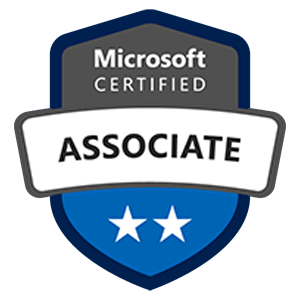
Earn your Microsoft Certified Associate (MCA) certification. Advance your career and upgrade your skills by achieving the Microsoft 365 Security Administrator Certification. This all-inclusive boot camp training covers courses:
Click below to view upcoming instructor-led course dates.

TechSherpas 365 has been a trusted Microsoft Partner for Learning Solutions for 25 years and counting.
We'll beat or match any competitors price for an equivalent boot camp certification training program.
We're so confident in the quality of our training, our boot camps include a 100% Test Pass Guarantee.*
Our certification boot camps include courseware, labs, test simulation and official exams.*
*Must select Certification Package upgrade upon class registration*



About this course
Help protect against credential compromise with identity and access management. In this course you will learn how to secure user access to your organization’s resources. Specifically, this course covers user password protection, multi-factor authentication, how to enable Azure Identity Protection, how to configure Active Directory federation services, how to setup and use Azure AD Connect, and introduces you to Conditional Access. You will also learn about solutions for managing external access to your Microsoft 365 system.
Threat protection helps stop damaging attacks with integrated and automated security. In this course you will learn about threat protection technologies that help protect your Microsoft 365 environment. Specifically, you will learn about threat vectors and Microsoft’s security solutions for them. You will learn about Secure Score, Exchange Online protection, Azure Advanced Threat Protection, Windows Defender Advanced Threat Protection, and how to use Microsoft 365 Threat Intelligence. It also discusses securing mobile devices and applications. The goal of this course is to help you configure your Microsoft 365 deployment to achieve your desired security posture.
Information protection is the concept of locating and classifying data anywhere it lives. In this course you will learn about information protection technologies that help secure your Microsoft 365 environment. Specifically, this course discusses information rights managed content, message encryption, as well as labels, policies and rules that support data loss prevention and information protection. Lastly, the course explains the deployment of Microsoft Cloud App Security.
Internal policies and external requirements for data retention and investigation may be necessary for your organization. In this course you will learn about archiving and retention in Microsoft 365 as well as data governance and how to conduct content searches and investigations. Specifically, this course covers data retention policies and tags, in-place records management for SharePoint, email retention, and how to conduct content searches that support eDiscovery investigations. The course also helps your organization prepare for Global Data Protection Regulation (GDPR).
Audience profile
This course is for the Microsoft 365 security administrator role. This role collaborates with the Microsoft 365 Enterprise Administrator, business stakeholders and other workload administrators to plan and implement security strategies and ensures that the solutions comply with the policies and regulations of the organization.
This role proactively secures Microsoft 365 enterprise environments. Responsibilities include responding to threats, implementing, managing and monitoring security and compliance solutions for the Microsoft 365 environment. They respond to incidents, investigations and enforcement of data governance.
The Microsoft 365 Security administrator is familiar with Microsoft 365 workloads and has strong skills and experience with identity protection, information protection, threat protection, security management and data governance. This role focuses on the Microsoft 365 environment and includes hybrid environments.
At course completion
After completing this course, students should be able to:
PART 1
Module 1: User and Group Security
This module explains how to manage user accounts and groups in Microsoft 365. It introduces you to Privileged Identity Management in Azure AD as well as Identity Protection. The module sets the foundation for the remainder of the course.
Lessons
Lab : Managing your Microsoft 365 Identity environment
After completing this module, students should be able to:
Module 2: Identity Synchronization
This module explains concepts related to synchronizing identities. Specifically, it focuses on Azure AD Connect and managing directory synchronization to ensure the right people are connecting to your Microsoft 365 system.
Lessons
Lab : Implementing Identity Synchronization
After completing this module, students should be able to:
Module 3: Federated Identities
This module is all about Active Directory Federation Services (AD FS). Specifically, you will learn how to plan and manage AD FS to achieve the level of access you want to provide users from other directories.
Lessons
After completing this module, students should be able to:
Module 4: Access Management
This module describes Conditional Access for Microsoft 365 and how it can be used to control access to resources in your organization. The module also explains Role Based Access Control (RBAC) and solutions for external access.
Lessons
After completing this module, students should be able to:
PART 2
Module 1: Security in Microsoft 365
This module starts by explaining the various cyber-attack threats that exist. It then introduces you to the Microsoft solutions to thwart those threats. The module finishes with an explanation of Microsoft Secure Score and how it can be used to evaluate and report your organizations security posture.
Lessons
After completing this module, students will be able to:
Module 2: Advanced Threat Protection
This module explains the various threat protection technologies and services available in Microsoft 365. Specifically, the module covers message protection through Exchange Online Protection, Azure Advanced Threat Protection and Windows Defender Advanced Threat Protection.
Lessons
Lab : Advanced Threat Protection
After completing this module, students will be able to:
Module 3: Threat Intelligence
This module explains Microsoft Threat Intelligence which provides you with the tools to evaluate and address cyber threats. You will learn how to use the Security Dashboard in the Microsoft 365 Security and Compliance Center. It also explains and configures Microsoft Advanced Threat Analytics.
Lessons
Lab : Advanced Threat Analytics
After completing this module, students will be able to:
Module 4: Mobility
This module is all about securing mobile devices and applications. You will learn about Mobile Device Management and how it works with Intune. You will also learn about how Intune and Azure AD can be used to secure mobile applications.
Lessons
After completing this module, students will be able to:
PART 3
Module 1: Information Protection
This module explains information rights management in Exchange and SharePoint. It also describes encryption technologies used to secure messages. The module introduces how to implement Azure Information Protection and Windows Information Protection.
Lessons
Lab : Data Loss Prevention
After completing this module, students will be able to:
Module 2: Data Loss Prevention
This module is all about data loss prevention in Microsoft 365. You will learn about how to create policies, edit rules, and customize user notifications.
Lessons
Lab : Data Loss Prevention
After completing this module, learners should be able to:
Module 3: Cloud Application Security
This module is all about cloud app security for Microsoft 365. The module will explain cloud discovery, app connectors, policies, and alerts.
Lessons
After completing this module, students will be able to:
PART 4
Module 1: Archiving and Retention
This module explains concepts related to retention and archiving of data for Microsoft 365 including Exchange and SharePoint.
Lessons
Lab : Archiving and Retention
After completing this module, you should be able to:
Module 2: Data Governance in Microsoft 365
This module focuses on data governance in Microsoft 365. The module will introduce you to Compliance Manager and discuss GDPR.
Lessons
After completing this module, you should be able to:
Module 3: Managing Search and Investigations
This module is focused on content searching and investigations. Specifically, it covers how to use eDiscovery to conduct advanced investigations of Microsoft 365 data. It also covers audit logs and discusses GDPR data subject requests.
Lessons
Lab : eDiscovery
After completing this module, you should be able to: